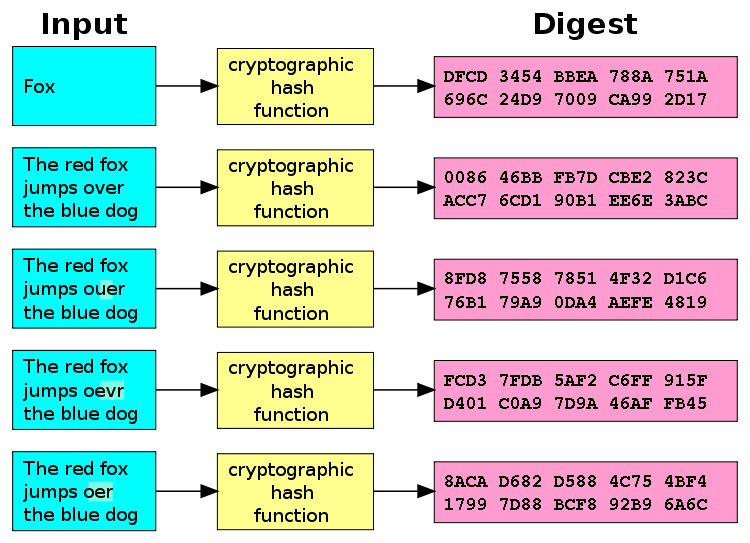Hashing
Hashing is one of the cornerstones of all cryptography.
We can create a number/string that represents the contents of something, without knowing what that thing is- we are translating the contents of something else into a fixed length number.
Cyphers:
Transform one text into something else:
Encoding a cipher example: a-z == 1-26 ==> aaa == 111 one letter forwards ==> "hello" == "ifmmp"
Hashing is just a mathematically irreversable cipher. We can't get the actual contents of the hash back out.
This is hard because of one of the properties prime numbers.
The ideal cryptographic hash function has five main properties:
- it is deterministic so the same message always results in the same hash
- it is quick to compute the hash value for any given message
- it is infeasible to generate a message from its hash value except by trying all possible messages
- a small change to a message should change the hash value so extensively that the new hash value appears uncorrelated with the old hash value
- it is infeasible to find two different messages with the same hash value

Hashing turns out to be the best way to store a string that you need to know is legitimate, but don't actually care what the string is. (Or you specifially don't want to know what the string is)
Passwords work by storing a hash of the password, then throwing the actual password away.
Uses of hashes:
- git
- bitcoin
- file integrity
- ssh / https / encryption
- TOR / darkweb
Password Hashing
For password protection we'll use sha256. sha256 creates highly secure salted passswords. Learn more about sha256: SHA-2. Note that sha256 hashes passwords in an extremely secure way. It differs from other hashing methods like MD5 by putting a roadblock in the way between the hash and a hacker (specifically, time). Let's see how this works.
To use sha256 in node we need to install / use the sha256 npm module.
Install sha256
npm install js-sha256
Hash password
// require it
var sha256 = require('js-sha256');
//example
sha256('The quick brown fox jumps over the lazy dog'); // d7a8fbb307d7809469ca9abcb0082e4f8d5651e46d3cdb762d02d0bf37c9e592
Authentication
We can see whether or not a user is authentic, but do we want them to enter their password for each request? What if they need permission for photos whose src is embedded in a page?
We can use cookies to mark whether a user has been authenticated or not.
User Records
In order to store the password hash, we will need to introduce the idea of having a user and the associated information stored on the server.
Process:
create user:
- user makes GET request to server for the register form
- user fills out form and submits a POST request
- server recieves POST request
- hashes password
- creates user record
- server sets a cookie in the header of the response.
- all subsequent requests to the server will have the
logged_incookie
login ( user is not currently logged in )
- user makes GET request to server for the login form
- user fills out form and submits
- server recieves POST request
- gets user record
- hashes password
- compares hash to what is in the record
- if record and hash match, set a cookie in the response header
logout ( user is logged in )
- user makes POST request for logout
- server recieves POST request
- server sends clear cookie in response header
Pairing exercise:
Create a command line app that hashes the argument:
Create a new dir
mkdir hashing
cd into it
cd hashing
init a new package json
npm init
add sha256
npm install js-sha256
require it at the top of the file
const sha256 = require('js-sha256');
take an argument and hash it
let input = process.argv[2];
let hash = sha256(input);
copy/paste that output somewehere, and then write code that compares two hashes:
let otherInput = process.argv[2];
if( hash === sha256(otherInput) ){
console.log("same");
}else{
console.log("not same");
}